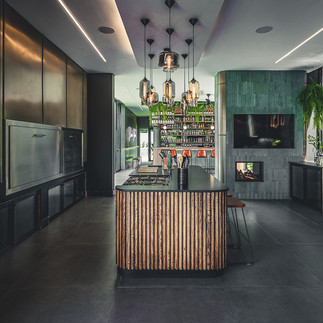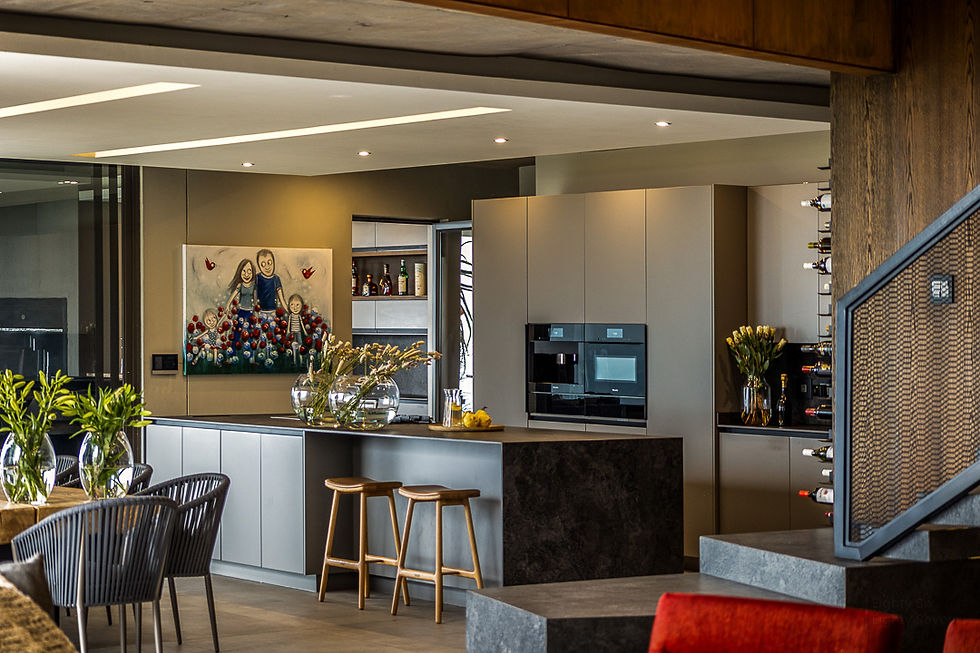What It’s Really Like Working with a Designer: Myths vs. Reality
- Theo Arewa-Bothma

- May 8
- 8 min read
Debunking Common Misconceptions About Interior Designers; What Luxury Clients Should Really Expect From a High-End Design Partnership
Imagine this: you walk into your newly completed home after months abroad. The sun cascades through glass walls that weren’t there before, warming a bespoke travertine floor that looks almost too perfect to touch. The air smells faintly of cedar and polished brass. There’s a quiet elegance in every detail, from the handcrafted sconces to the custom cabinetry designed around your personal collection of French vintage glass. You didn’t choose every doorknob yourself; but somehow, it all feels unmistakably yours.
This is what working with a designer should feel like.
Yet for many, the idea still stirs uncertainty. We’ve heard the questions before:
“Will they really listen to me?”
“Do designers push their own style instead of mine?”
“Isn’t it faster and easier to manage it myself?”
At 8687 Studios, we work with discerning individuals who are used to leading with vision, investing with intention, and living with meaning. Our clients aren’t just hiring a service; they’re curating an experience. And that journey begins with trust.
So let’s pull back the curtain. In this article, we’re unpacking the most common myths about working with a designer and revealing the reality that’s often more bespoke, collaborative, and efficient than you might imagine.
Myth #1: “Hiring a Designer Means Losing Creative Control”
Reality: The best design partnerships begin with your vision and elevate it, not overwrite it.
A common misconception about working with an interior designer is that you’ll be handing over the creative reins; and with them, your identity. But in truth, the most successful design collaborations don’t suppress the client’s voice; they refine it, articulate it, and give it form.
Take, for instance, a project we completed on the southern coast of France: a cliffside villa, bold in its architecture yet meditative in spirit. The client, a well-traveled philanthropist with a growing contemporary art collection, came to us with a deceptively simple request: “I want the home to breathe. Nothing cluttered. Nothing cold.” He wanted minimalism, but not emptiness. Structure, but also soul.
At 8687 Studios, this is where the design process begins; not with samples and blueprints, but with deep conversation. We don’t just ask what colors you like. We ask what moves you. What pieces in your collection hold emotional weight? Where do you seek quiet in your day? What should this space say when no one is speaking?
The answers to those questions became the raw material of our design. We sourced limestone from nearby quarries to echo the texture of the surrounding cliffs and paired it with reclaimed French oak that gave the floors a lived-in warmth. A sculpture that held sentimental value was placed not as an afterthought, but as a centerpiece around which the main corridor was proportioned. Every element was grounded in the client’s narrative, translated through our design language.
In this way, creative control is never taken; it’s amplified. Working with a designer is not about surrendering your preferences; it’s about stepping into a collaborative process where your ideas are sharpened, supported, and brought to life with precision. It’s the difference between directing every brushstroke yourself and working with a master painter who knows exactly how to bring your vision to canvas.
Myth #2: “The Process Is Painfully Slow and Bureaucratic”
Reality: A well-structured design journey is both efficient and intentional, designed to keep you informed and not overwhelmed.
There’s a familiar skepticism we often encounter from clients who’ve been through renovations or builds in the past: a wariness of timelines that stretch endlessly, of decisions buried under red tape, and of weeks lost to miscommunication between contractors, suppliers, and project leads. And truthfully, in the wrong hands, design can feel like a long and winding road with no map.
But at 8687 Studios, we treat process the same way we treat design: curated, clear, and built around you.
One recent project, a penthouse overlooking Lake Geneva, exemplifies this. The client, a tech entrepreneur with a fast-paced lifestyle, had just acquired the property and wanted it fully transformed within six months without compromising on materiality, craftsmanship, or innovation. He wasn’t interested in delays, surprises, or the constant back-and-forth he’d experienced on previous projects.
From day one, we outlined the entire journey: concept design, schematic development, procurement, site installation, and final styling; each with clearly defined timelines, deliverables, and decision points. Weekly virtual updates, 3D walkthroughs, and a custom-built project dashboard allowed him to track progress in real time, whether he was in Zurich, New York, or Tokyo. Every meeting had a purpose. Every decision had context.
Behind the scenes, our team handled the complexity; coordinating artisans, managing suppliers, anticipating bottlenecks, so the client only had to focus on what truly required his input. And yes, the project was delivered on time, complete with bespoke furnishings, integrated smart-home technology, and finishes that balanced sleek modernity with warmth and character.
The design process isn’t meant to be a labyrinth. When properly orchestrated, it feels more like a symphony; each phase building on the last, each moment purposeful. It’s about offering clarity without sacrificing creativity and momentum without rushing meaning.
So if the idea of working with a designer conjures images of endless meetings and stagnant timelines, let us shift the frame. With the right studio, the process doesn’t drag; it flows.
Myth #3: “Designers Only Follow Trends”
Reality: Exceptional design transcends trend; it reflects place, purpose, and personal legacy.
There’s a prevailing assumption, particularly in the world of high-end interiors, that designers are constantly chasing the latest aesthetic movement. Arched doorways this year, monochrome palettes the next. But true luxury doesn’t chase trends; it establishes timelessness.
We were reminded of this while working on a townhouse in Johannesburg’s historic Westcliff district; a home with strong bones but little identity. The new owners, a couple relocating from Europe, had an aversion to “Instagram interiors.” Their brief was clear: nothing that would feel dated in a decade, and nothing that looked like it had been plucked from a showroom floor.
Our response was not to impose a style, but to uncover a narrative. The home sat on a slope flanked by ancient jacaranda trees, with extraordinary afternoon light flooding in from the west. We leaned into that context. We sourced hand-cut local stone for the façade and introduced deep-set windows with bronze detailing to ground the home in its environment. Inside, the palette drew from the natural surroundings; muted clay tones, eucalyptus greens, and soft charcoals that echoed the stormy Highveld sky.
The couple’s existing collection of Danish mid-century furniture was woven into the design; not replaced, not reinterpreted. We built the home around their pieces, treating them as heirlooms rather than obstacles.
At 8687 Studios, we design spaces that are not only rooted in context but also built to last. That means using sustainable materials that age beautifully: wide-plank oak that gains character with time, low-VOC finishes that prioritize wellness, and smart systems that adapt quietly in the background. We care less about what’s “on trend” this year and more about what will still inspire you a decade from now.
Timeless interiors don’t announce themselves loudly. They whisper through harmony, restraint, and integrity. They grow more meaningful with age, just like the people who inhabit them.
So if you’re worried that working with a designer means giving in to fleeting fashion, consider this: the best spaces aren’t trend-driven. They’re you-driven.
Myth #4: “Design Services Are an Unnecessary Luxury”
Reality: Thoughtful design isn’t a splurge, it’s an investment in how you live.
For many, the idea of hiring a designer feels indulgent. It’s often misunderstood as an aesthetic exercise, a nice-to-have rather than a necessity. But at 8687 Studios, we see interior design not as decoration, but as architecture for daily life. When done well, it supports how you live, how you host, how you retreat, and how you feel at home in your own space.
One of our clients, a private equity executive who splits time between London, Accra, and Cape Town, approached us with a request that was less about design and more about life. His brief: “I want to arrive, put down my bag, and feel at peace. Nothing should be shouting for attention. Everything should feel exactly where it belongs.”
He didn’t want opulence. He wanted ease.
Design, in this context, became an instrument for wellbeing. We created a space that responded intuitively to his routines. A lighting system that shifted gently throughout the day, supporting his circadian rhythm. Textiles chosen not only for beauty but for the way they soothed the senses, washed linens, handwoven mohair, and natural wool underfoot. A walk-in wardrobe that mirrored his travel habits, designed like a boutique with specific zones for each city. No detail was accidental. Every choice had a reason.
And that’s the core truth: when interior design is approached with depth and precision, it pays dividends. In time saved. In stress reduced. In the pleasure of waking up every morning in a space that fits you like a second skin.
For our clients, who often lead complex, high-performance lives, design isn’t a luxury; it’s a stabilizing force. It allows their homes to function beautifully without friction. To host without hassle. To recharge without effort.
The investment isn’t in furniture or finishes. It’s in clarity. In comfort. In an environment that elevates every moment of your everyday.
Myth #5: “It’s Better to Wait Until Everything’s Ready Before Bringing in a Designer”
Reality: Bringing in a designer early prevents costly mistakes, ensures cohesion, and maximizes the potential of your space.
It’s a myth we encounter time and time again: “We’ll finish the build first, then bring in a designer to do the interiors.” While it may seem logical on the surface, this approach often results in missed opportunities and expensive rework.
One of our most memorable projects, a contemporary estate on the outskirts of Marrakech, illustrates the difference early design input can make. The client, a creative director with impeccable taste, had already commissioned an architect to develop the structural layout of the home. But midway through the initial plans, she reached out with a concern: “It’s beautiful, but it doesn’t feel like me. And I don’t want to regret this when it’s done.”
We stepped in at a pivotal point; not too late, but not early enough to avoid certain inefficiencies. The layout had been approved, but spatial flow hadn’t yet been aligned with how she truly lived. For example, the master suite had expansive views, but limited privacy. The kitchen was grand, but lacked functional storage. And the hallway connecting the guest quarters felt like an afterthought.
We worked alongside the architect to realign priorities: reshaping transitions between public and private zones, adjusting window placements for both light and privacy, and integrating design elements that would eventually inform material selections, furniture proportions, and lighting design. In short, we turned a beautiful shell into a living, breathing environment, with the client’s lifestyle at the core.
When designers are brought in late, decisions have often been made without consideration for how space, function, and aesthetics intersect. You might end up with a room that looks spectacular on paper, but doesn’t quite accommodate your art collection, your family rituals, or the way you entertain.
By integrating design from the outset, every detail is intentional. Ceiling heights are chosen with lighting in mind. Window placements frame not only views, but furniture layouts. Built-ins are conceived to suit your storage needs, not someone else’s assumptions.
At 8687 Studios, we believe the earlier you engage a designer, the more holistic and harmonious the result. We don’t just decorate what’s left behind. We help shape what’s possible.
Working with an interior designer isn’t about surrendering your taste or complicating the process; it’s about collaboration at the highest level. It’s about shaping a space that reflects who you are, supports how you live, and evolves with your aspirations.
Throughout this article, we’ve unpacked five of the most persistent myths: the fear of losing creative control, the belief that the process is slow and inefficient, the assumption that design is trend-driven, the idea that it’s an unnecessary luxury, and the notion that designers come in too late to make a real impact. In reality, each of these myths conceals an opportunity: the chance to work smarter, live better, and inhabit spaces that don’t just look beautiful, but feel meaningful.
At 8687 Studios, design is never one-size-fits-all. It's curated, considered, and deeply personal. Our role is not to impose but to interpret, to take your vision and bring it into harmony with materiality, light, proportion, and purpose. The end result? A home that doesn’t just impress others, it restores you.
So whether you’re building from the ground up, reimagining a legacy property, or simply seeking to elevate the everyday, know this: the right design partnership is not a luxury. It’s a powerful investment in clarity, beauty, and longevity.













Comments